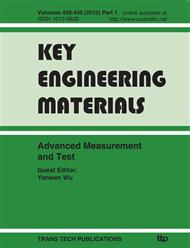p.1432
p.1438
p.1444
p.1450
p.1456
p.1463
p.1469
p.1475
p.1481
In Vitro Selection of Oligonucleotide Acid Aptamers against Pathogenic Vibrio Alginolyticus by SELEX
Abstract:
Detection of pathogenic microorganism is very necessary in the control of infectious disease prevailing in aquiculture animals. However, most of the present techniques can not meet the need of the quick field inspection. Systematic evolution of ligands by exponential enrichment (SELEX) is a new molecular recognition way for generating high affinity oligonucleotide acid aptamers, a new nucleotide acid material, which have been widely used in the detections of proteins, cells and so on. In the present paper, the technology was applied to select the high affinity aptamers against pathogenic microorganism Vibrio alginolyticus, which could be used for the rapid field detection of the microorganism. Based on the designment of the ssDNA library of 76 nucleotide acids with 35-base random region, the SELEX system for the selection of the high affinity aptamers against Vibrio alginolyticus was established. In the SELEX system, asymmetric PCR was proved to be a better amplification method for the ssDNA library than the reported affinity magnetic bead method, and the corresponding parameters of the asymmetric PCR were also studied and optimized. The affinity of the final ssDNA library increased by nearly 200% compared with the original library. Cloning and sequencing of the final ssDNA library showed that there were at least two kinds of ssDNAs with different length in the affinity ssDNA library: one was 76 bases, another was 149 bases. Simulation of the secondary structures showed that the secondary structures of the two fragments were different greatly, suggesting that the two fragments could bind to different sites of V. alginolyticus surface.
Info:
Periodical:
Pages:
1456-1462
Citation:
Online since:
June 2010
Authors:
Price:
Сopyright:
© 2010 Trans Tech Publications Ltd. All Rights Reserved
Share:
Citation:


